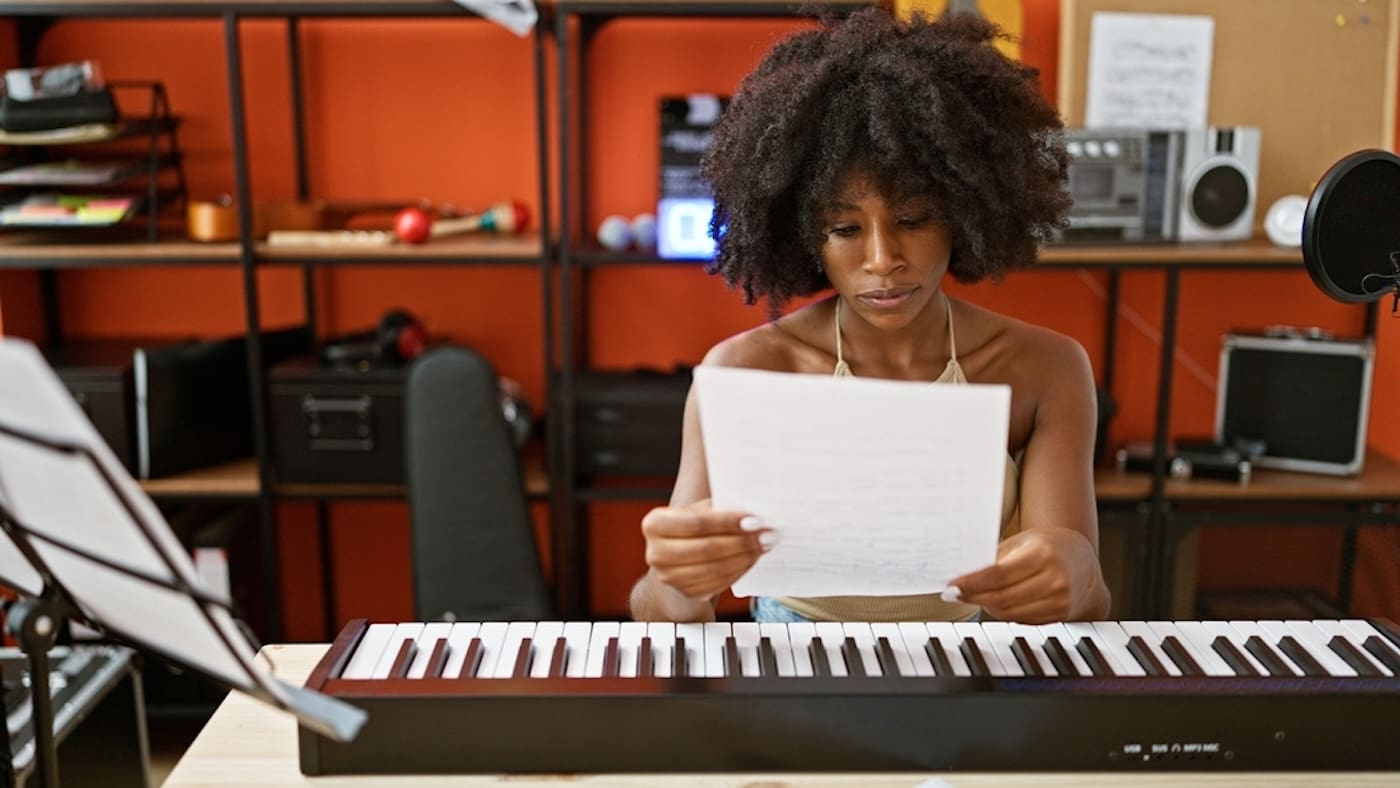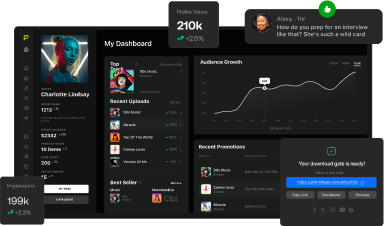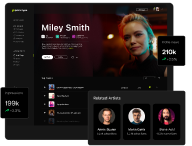
Record labels thrive on discovery, building a roster of exceptionally talented artists, producers, and songwriters.
That’s where artists and repertoire (A&R) representatives come into play, identifying emerging artists with the potential for commercial success.
In this guide, you’ll learn what A&R is, how it works behind the scenes, and how you can stand out and get noticed as an independent artist.
Get Early Access
To Promo Hype
What Is A&R In Music?
A&R stands for Artists and Repertoire, a music term that relates to a label or publishing company division or individual that handles talent discovery.
The A&R department is core to talent acquisition, but also plays a key role in their creative process and commercial development.
For smaller labels, a single person handles A&R, whereas larger publishers have dedicated A&R teams working behind the scenes.
As music professionals, A&R representatives are up to speed on popular music genres and what to look for in the next breakthrough act.
Related read: Artist management 101.
What Do A&Rs Do?
Identifying up-and-coming talent is just the beginning of what A&R representatives do; it involves multiple roles throughout artists’ development.
A&Rs approach talent development with a holistic mindset, assisting their approach to making music and arranging collaborations.
They’re also closely involved in building an artist’s brand, using their persona to promote new releases to fans.
Negotiating contracts and working with record labels and publishing companies are also core responsibilities A&Rs adopt.
Why Is A&R Important?
The methods used by A&Rs may have changed over the years, but their importance in the music business remains the same.
Here’s why A&R benefits so many artists when developing their talents and facilitating their careers:
- Understanding commercial potential: Most A&Rs have a firm grasp of the music industry, often with a background in songwriting or production. This foundation enables them to recognize artists with strong commercial potential and connect them with the most appropriate collaborators.
- Providing artists with music business contacts: A&Rs have extensive connections that can support the artistic development of new artists. This includes arranging collaborations and promotions with other performers to build their online audience.
- Supervision of music production: Since A&Rs are associated with labels and publishers, they have access to professional music production facilities for signed artists. This extends to facilitating connections with experienced producers, sound engineers, and session musicians on projects.
Since A&R departments are deeply rooted in the music industry, they offer valuable insights and connections that help artists thrive.
Read more: How to get signed to a record label.
The Role Of A&R For Record Labels
As the first port of call for record labels seeking artists, A&Rs use their expertise to focus on the most promising talent.
Let’s take a closer look at the four primary responsibilities of A&R departments when hunting for the next big thing:
1. Scouting Talent
A&R representatives are often visualized as hanging out at small venues and events, waiting to spot new talent to sign to a label.
While clubs, concerts, and festivals still play a role in A&R, today’s talent scout is equally at home in online spaces.
Social media and music websites like Bandcamp are essential for today’s talent scouts, filtering through thousands of profiles.
Many successful independent artists build their audience online, and A&Rs are constantly on the lookout for originality.
If you’re a new act with talent, charisma, and a growing online audience, A&Rs likely have you on their radar.
2. Creative Development For New Talent
The ability of A&Rs to identify new talent is matched by a keen understanding of how to foster their creative process and development.
A&Rs appreciate what songwriters and music producers do, transforming new artists into polished, professional acts.
They provide creative input on songwriting decisions, helping artists grow by refining their sound and core appeal.
Creative development also extends to the artist’s image and how their presentational style can be used to appeal to niche audiences.
3. Overseeing Music Recording
A&Rs liaise with various departments within a record label when working with new artists, overseeing projects from conception to release.
They connect acts with producers and musicians to enable them to record music that meets the label’s standards.
A&Rs will sometimes offer creative input into compositional aspects, suggesting ways to improve the song’s structure and arrangement.
Additional roles include facilitating access to a recording studio and booking sessions with musicians and backing vocalists.
Once the recording artists have finished, A&Rs advise on which tracks to release on EPs and albums, or as dedicated singles.
Throughout the process, A&Rs serve as the go-between for artists and labels, ensuring that contractual terms are adhered to.
4. Marketing & Promotion
Once the recording sessions are complete, A&Rs are closely involved with helping artists make money from their music.
Working alongside the act, they formulate a basic promotional foundation that combines online marketing and live performances.
A&Rs can leverage media and journalism connections to promote music directly to relevant music fan platforms.
This includes submitting music to radio stations and ensuring the best tracks are in constant rotation with regular airplay.
As with their other roles, A&R managers negotiate between artists and the record company to ensure a coherent vision is implemented.
Get Early Access
To Promo Hype
How Independent Artists Can Attract A&R Attention
A common dream for many unsigned artists is to be noticed by an A&R representative at a major label.
If you’re hoping to attract the attention of A&Rs, here’s what you’ll need to focus on:
- Building a strong online presence: Going viral is a surefire way to attract A&R attention, and a solid online presence is a must. Keep your website and social media presence up to date and engage with your following regularly.
- Recording professional demos: Connecting with an A&R representative often requires a proactive approach, including submitting your best tracks for consideration. Before sending them to an A&R rep, invest in professional mixing and mastering services to polish the final production.
- Creating electronic press kits (EPKs): A&Rs are often swamped with new artists, and EPKs are an effective way to consolidate information in a single place. By understanding what an EPK is, you can craft one that captures your act’s core appeal and music genre.
- Gigging at the right venues: Live shows are where a singer’s or band’s charisma truly shines through to the audience. This means getting gigs as a musician in venues where talent scouts are most likely to hang out.
- Submitting to editorial playlists: Many streaming platforms feature editorial playlists that highlight new artists to millions of potential listeners. Submit tracks to playlists on Spotify and Apple Music using each platform’s dedicated “pitching” tools and gain considerable exposure if approved.
Ultimately, A&Rs are laser-focused on seeking out quality music, so honing your composition and performance skills is essential.
A&R Resources For Independent Artists
Implementing the strategies outlined above for capturing A&Rs’ attention requires the necessary tools and resources.
Here’s everything you need to showcase your musical abilities where A&Rs are most likely to see them:
- Music industry platforms: Outlets such as Music Business Worldwide and the Recording Industry Association of America provide ongoing updates on industry trends. You can also use the “who’s looking” service available through ASCAP to connect with A&R companies actively seeking new artists.
- Digital music distribution services: Building a substantial discography online means hitting all the major music streaming services with regular content. Using a digital music distribution service streamlines the process, freeing up time to focus on writing music.
- Data-driven platforms: Websites such as Chartmetric, Viverate, and others provide robust analytics that A&Rs use to track artistic performance and popularity. By studying these platforms, artists can make data-driven decisions about where to focus their efforts online.
- Music discovery websites: Popular platforms like Bandcamp and SoundCloud (where Billie Eilish was discovered) have become primary sources for A&Rs seeking breakthrough acts. They’re also excellent for direct-to-fan sales and exposure, with potential royalties depending on the distribution arrangement.
- Social media management tools: Managing multiple social media pages is another time-consuming but necessary aspect of self-promotion. Tools like Hootsuite and Social Blade streamline posting and help you track your channel’s growth.
These and other powerful automation tools are valuable resources that free up time without compromising quality.
Discover more: The 10 best music marketing tools.
The Future Of A&R In The Music Industry
A&R departments are inherently adaptable, whether it’s spotting new music trends or embracing data and emerging technology.
Here’s how A&R’s role in the music industry and approach to artist acquisition will shape up in the future:
The Role Of Social Media
Measuring the popularity and personalities of new artists primarily involves social media and engagement.
Platforms like Instagram and TikTok are central to artistic development and reputation-building through strong social media strategies.
As they continue to play a critical role in exposure, A&Rs will increasingly focus on artists with a strong social media presence.
This growth will be accentuated by data analysis, promoting artists on platforms that deliver the best results.
New Technology & Data-Driven Decisions
Monitoring data will also play an increasingly significant role in other A&Rs’ work to support artistic growth and monetization.
This focus is evident in the emergence of powerful new tools for A&R, such as Sodatone, recently acquired by Warner Music Group.
Such platforms deliver robust metrics covering streaming numbers, social media followings, and live touring data.
A&Rs can then analyze this data to gain insights into fan loyalty and engagement and to determine artists’ potential virality.
Remote-Based Artistic Development
With many grassroots venues struggling to draw in audiences, remote-based artistic development is increasingly common for A&Rs.
Online talent scouting and artist development are also easier than ever, with remote collaboration common across many industries.
The strong interpersonal and communication skills of A&Rs will be increasingly applied through remote consultations and relationship-building.
Likewise, projects can be managed and coordinated remotely using tools that facilitate ongoing discussions about their creative direction.
Learn more: How to start a music career.
A&R FAQs
In case you still have queries about the role of A&Rs in the music industry, here are some answers to the most frequently asked questions.
How do A&Rs get paid?
A&R professionals are primarily paid through salaries from a label or publishing company, but some senior roles also earn performance-based compensation.
Known as “points,” this compensation pays a percentage of music royalties, typically 1% to 2% of music sales.
Such payments are often made only once a specific sales threshold is met, with the points system initiated at that stage.
Additional income sources for A&Rs can include incentives like bonuses for developing a hit act and other revenue-sharing arrangements.
Is A&R still relevant?
While the role of A&R representatives has changed significantly in recent years, their position in the music industry is as relevant as ever.
A&R continues to connect up-and-coming artists with the best music producers, managing multiple aspects of their careers.
They’re also crucial for achieving commercial success, providing the financial backing and marketing expertise independent artists lack.
Vital for small and major labels, A&R’s ability to negotiate deals and mentor new talent has increased in scope.
Who are some famous A&R people?
With A&Rs responsible for making things happen for new artists, there’s no shortage of success stories littered throughout music history.
Legendary figures like Clive Davis and Chris Lighty have brought superstars like Whitney Houston and Busta Rhymes to the public eye.
Likewise, some of the greatest hip-hop A&Rs have noticed and promoted innovative acts that have revolutionized the genre.
In some cases, successful A&Rs have risen through the ranks to become label executives, producing for music’s legendary performers.
Summary
The state of the music industry is constantly changing, but the role of A&Rs remains a vital bridge between creativity and opportunities.
For artists, this means refining your musical abilities and building an online presence that aligns with A&R professionals.
By forging a clear vision and identity, you can develop an artist brand and build a career that attracts A&Rs’ attention.
Get Early Access
To Promo Hype
Join Promo Hype






